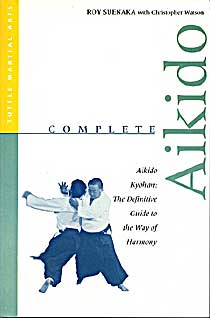Complete Aikido
Aikido Kyohan: The Definitive Guide to the Way of
Harmony
Roy Suenaka and Christopher Watson
Tuttle Press, $19.95
ISBN 0-8048-3140-8
 This is the first and welcome book by Roy Suenaka,
an early pioneer of American aikido with impressive
credentials: he studied both under aikido's founder
Morihei Ueshiba O'Sensei, as well as Koichi Tohei.
Karate-ka will also find the book interesting since
it details the author's studies in other martial arts,
most notably karate under the Okinawan legend, Hohan
Soken.
This is the first and welcome book by Roy Suenaka,
an early pioneer of American aikido with impressive
credentials: he studied both under aikido's founder
Morihei Ueshiba O'Sensei, as well as Koichi Tohei.
Karate-ka will also find the book interesting since
it details the author's studies in other martial arts,
most notably karate under the Okinawan legend, Hohan
Soken.
The details and history of Suenaka's background are
laid out in the book's initial biographical section,
which gives Suenaka's perspective on the early years
of aikido in Hawaii, his bringing aikido to Okinawa,
the rift that developed between Kisshomaru Ueshiba
and Tohei, Tohei's separation from the Aikikai (Usehiba's
Association), and the early development of Tohei's
Ki Society, in which Suenaka was one of the first
shihan (senior instructors). Drawing on his study
under both O'Sensei and Tohei Sensei, Suenaka affords
the reader rare insight not only into the methods
and personalities of these two men, but also into
the ongoing debate concerning whether aikido is more
a philosophical, spiritual discipline than an effective
means of self-defense. The style is informal and highly
readable mixed with wit, humor, and colorful, often
amazing stories -- such as Ueshiba's demonstrations
of ki -- all aptly portrayed by co-author Christopher
Watson. These stories alone are worth the price of
admission.
The second half of the book is devoted to etiquette,
basic exercises and techniques of Suenaka-Ha Tetsugako-Ho
Wadokai Aikido. Many photos and detailed descriptions
are included. This is not just another "How To" of
basics section. Suenaka's emphasis is on effective
technique, including use of atemi (striking). Suenaka
also illustrates what he considers to be incorrect
technique. Clearly Sueneka believes aikido to be effective
as a self-defense art. The first half of the book
complements this assertion through many real- life
examples of street self-defense and dojo confrontations.
The dojo episodes are significant since Suenaka was
the first successfully to introduce aikido to Okinawa.
Confrontations and challenge were inevitable and his
success is testimony to both Suenaka's and aikido's
technical prowess -- something his background in judo,
boxing and karate assuredly helped to hone. Undoubtedly
these often tense early adventures also helped to
solidify his continued emphasis on effective technique.
The faults of the book are few. The first is that
static photos can never portray the flow of movement
and technique that is at the heart of the art. Thus
the casual viewer may find it difficult to judge some
aspects of Suenaka's technical proficiency. Perhaps
this flow can only be experienced through actual observation
and participation, or to a lesser extent through video.
The other limitation of the book is that the second
technical section does not include weapon defense,
self-defense against kicks, throws and other techniques,
although Suenaka notes that these aspects were deliberately
omitted for the sake of brevity. Nevertheless, their
omission prohibits the book from truly fulfilling
the promise of its title, Complete Aikido. No doubt
the reader can look forward to additional publications
by the authors which will cover the areas not included
in this first text.
return
to reviews

back
to top
home
| about
us | magazine
| learning
| connections
| estore
|